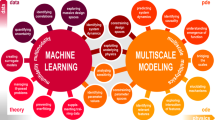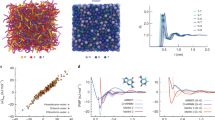Abstract
The tools we use at the human scale, whether mechanical, medical or microelectronic, depend on materials for which some other scale of length or time is critical. Often this is the mesoscale, between the scales of engineering and of atomic science. Linking underlying processes to what we handle is sometimes called 'spanning' (or 'bridging') length scales, giving the impression that the mesoscale is a swamp to be crossed without getting mud on our boots. This is misleading: we do not wish to span the mesoscale, but to work at the appropriate scale, and to connect that to our human needs. The appropriate scale need not rule out multiscale computer modelling, in which some supercode integrates relevant scales in one pass, hoping to combine the best of methods for two or more levels. But the reality for such attempts, too often, is that the worst of both regimes are found. Happily, simpler strategies at a judicious scale will often suffice.
This is a preview of subscription content, access via your institution
Access options
Subscribe to this journal
Receive 12 print issues and online access
$259.00 per year
only $21.58 per issue
Buy this article
- Purchase on Springer Link
- Instant access to full article PDF
Prices may be subject to local taxes which are calculated during checkout







Similar content being viewed by others
References
Weiner, S. & Wagner, H.D. The material bone: structure-mechanical function relations. Ann. Rev. Mater. Sci. 28, 271–298 (1998).
Gould, S.J. The Panda's Thumb: More Reflections in Natural History (Penguin, London, 1983).
Pettifor, D.G. Computer-aided materials design: bridging the gaps between physics, chemistry and engineering. Phys. Educ. 164–168 (May 1997).
Cottrell, A.H. Dislocations and Plastic Flow in Crystals (Clarendon, Oxford, 1953).
Henderson, D.J., Brodsky, M.H. & Chaudhari, P. Simulations of structural anisotropy and void formation in amorphous thin films. Appl. Phys. Lett. 25, 641–643 (1974).
Dirks, A. & Leamy, H.J. Columnar microstructure in vapor-deposited thin films. Thin Solid Films 74, 219–233 (1977).
Meakin, P. Fractal scaling in thin film condensation and material surfaces. CRC Crit. Rev. Solid State Mater. 13, 143–189 (1987).
Stoneham, A.M., Ramos, M.M.D. & Ribeiro, R.M. The mesoscopic modelling of laser ablation. Appl. Phys. A 69, S81–S86 (1999).
Holm, E.A. et al. On misorientation distribution evolution during anisotropic grain growth. Acta Metall. Mater. 49, 2981–2991 (2001).
Mindownik, M.A. et al. Scaling of dislocation structures: diffusion in orientation space. Proc. R. Soc. Lond. A 357, 1807–1819 (2001).
Wicksell, S.D. The corpuscle problem: A mathematical study of a biometric problem. Biometrika 17, 85–99 (1925).
Mouton, P.R. Principles and Practice of Unbiased Stereology (Johns Hopkins Univ. Press, Baltimore, 2002).
Larson, B.C., Yang, W., Ice, G.E., Budai, J.D. & Tischler, J.Z. Three-dimensional X-ray structural microscopy with submillimetre resolution. Nature 415, 887–890 (2002).
Evans, P.G., Isaacs, E.D., Aeppli, G., Cai, Z. & Lai, B. X-ray microdiffraction images of antiferromagnetic domain evolution in chromium. Science 295, 1042–1045 (2002).
Pawley, J.B. (ed.) Handbook of Biological Confocal Microscopy 2nd edn (Plenum, New York, 1995).
Boyde, A. Bibliography of confocal microscopy and its applications. Scanning 16, 33–56 (1994).
Venables, J.A. Introduction to Surface and Thin Film Processes (Cambridge Univ.Press, Cambridge, 2000).
Battaile, C.C. et al. Etching effects during the chemical vapor deposition of (100) diamond. J. Chem. Phys. 111, 4291–4299 (1999).
Barabasi, A.-L. & Stanley, H.E. Fractal Concepts in Surface Growth (Cambridge Univ. Press, Cambridge, 1995).
Rappaz, M. & Rettenmayr, M. Simulation of solidification. Curr. Opin. Solid State Mater. Sci. 3, 275–282 (1998).
Kermanpur, A. et al. Thermal and grain-structure simulation in a land-based turbine blade directionally solidified with the liquid metal cooling process. Metall. Mater. Trans. B 31, 1293–1304 (2000).
Boettinger, W.J. et al. Solidification microstructures: Recent developments, future directions. Acta Metall. Mater. 48, 43–70 (2000).
Aste, T. & Weaire, D. The Pursuit of Perfect Packing (Institute of Physics Publishing, Bristol, 2000).
Anderson, M.P., Srolovitz, D.J., Grest, G.S. & Sahni, P.S. Computer simulation of grain-growth 1.Kinetics. Acta Metall. 32, 783–791 (1984).
Holm, E.A., Srolovitz, D.J. & Cahn, J.W. Microstructural evolution in 2-dimensional 2-phase polycrystals. Acta Metall. Mater. 41, 1119–1136 (1993).
Holm, E.A. & Battaile, C.C. The computer simulation of microstructural evolution. J. Mater. 53, 20–23 (2001).
Choy, T.C. et al. in Computer Aided Innovation of New Materials (eds Doyama, M., Suzuki, T., Kihara, J. & Yamamoto, R.) 869–872 (Elsevier, Amsterdam 1991).
Sayes, R.S. & Thomas, T.R. Topography of random surfaces. Nature 271, 431–440 (1978).
Stoneham, A.M. & Tasker, P.W. Electronic structure and properties of oxide surfaces and interfaces. MRS Res. Symp. 40, 291–301 (1985).
Avnir, D., Farin, D. & Pfeifer, P. Molecular fractal surfaces. Nature 308, 261–263 (1984).
Goff, H.D. Colloidal aspects of ice cream, a review. Int. Dairy J. 7, 363–373 (1997).
Hartel, R.W. Ice crystallization during the manufacture of ice cream. Trends Food Sci. Tech. 7, 315–321 (1996).
Trgo, C., Koxholt, M. & Kessler, H.G. Effect of freezing point and texture regulating parameters on the initial ice crystal growth in ice cream. J. Dairy Sci. 82, 460–465 (1999).
Williamson, A.M., Lips, A., Clark, A. & Hall, D. Ripening of faceted ice crystals. Powder Tech. 121, 74–80 (2001).
Sutton, R.L., Evans, I.D. & Crilly, J.F. Modeling ice crystal coarsening in concentrated disperse food systems. J. Food Sci. 59, 1227–1233 (1994).
Weibull, W. A statistical theory of the strength of materials. R. Swedish Acad. Eng. Sci. Proc. 151 (1939).
Weibull, W. A. statistical distribution function of wide applicability. J. Appl. Mech. (New York) 18, 293–297 (1951).
Fisher, R.A. & Tippett, L.H.C. Limiting forms of the frequency distribution of the largest and smallest member of a sample. Proc. Camb. Phil. Soc. 24, 180–190 (1928).
Gumbel, E.J. Statistics of Extremes (McGraw-Hill, New York, 1958).
Smith, D.L. Thin Film Deposition; Principles and Practice (McGraw-Hill, New York, 1995).
Corbett, J. & Ianniello, L.C. Radiation-Induced Voids in Metals (US Atomic Energy Commission, Rockville, 1972).
Rauh, H.R., Stoneham, A.M. & Choy, T.C. in Materials Modelling: from Theory to Technology (eds Matthews, J.R., Rauh, H.R., Stoneham, A.M. & Thetford, R.) 201–208 (Institute of Physics Publishing, Bristol, 1992).
King, W.E. et al. Theory, simulation and modeling of interfaces in materials—bridging the length-scale gap: A workshop report. Mater. Sci. Eng. A 191, 1–16 (1995).
de la Rubia, T.D. & Bulatov, V.V. (eds) Materials research by means of multiscale computer simulation. Mater. Res. Bull. (Special Issue) 26, (2001).
Guo, X. (ed.) Multiscale materials modelling. Mater. Sci. Eng. A (in the press).
Friend, R.H. et al. Electroluminescence in conjugated polymers. Nature 397, 121–128 (1999).
Gao, Z.Q. et al. Organic electroluminescent devices by high temperature processing and crystalline transporting layer. Appl. Phys. Lett. 74, 3269–7321 (1999).
Halls, J.J.M. et al. Photodiodes based on polyfluorene composites: influence of morphology. Adv. Mater. 12, 498–502 (2000).
Stoneham, A.M. & Ramos, M.M.D. Mesoscopic modelling of conducting and semiconducting polymers. J. Phys. Cond. Mater. 13, 2411–2424 (2001).
Stoneham, A.M. et al. Understanding electron flow in conducting polymer films: injection, mobility, recombination and mesostructure. J. Phys. Cond. Mater. 14, 9877–9898 (2002).
Dickinson, J.T., Jensen, L.C., Webb, R.L., Dawes, M.L. & Langford, S.C. Interaction of wide band-gap single crystals with 248nm excimer laser irradiation. J. Appl. Phys. 74, 3758–3767 (1993).
Carter, G. in Erosion and Growth of Solids Stimulated by Atom and Ion Beams (eds Kiriakides, G., Carter, G. & Whitton, J.L.) 70 (Holland: Martin Nijhoff, The Hague, 1986).
Bianchi, L., Leger, A.C., Vardelle, M., Vardelle, A. & Fauchais, P. Splat formation and cooling of plasma-sprayed zirconia. Thin Solid Films 305, 35–47 (1997).
Fauchais, P., Vardelle, A. & Dussoubs, B. Quo vadis plasma spraying? J. Thermal Spray Tech. 10, 44–66 (2001).
Bertagnolli, M., Marchese, M., Jacucci, G., Doltsinis, I.S. & Nölting, S. Thermomechanical simulation of the splashing of ceramic droplets on a rigid substrate. J. Comput. Phys. 133, 205–221 (1997).
Doltsinis, I.S., Harding, J.H. & Marchese, M. Modelling the production and performance analysis of plasma-sprayed ceramic thermal barrier coatings. Arch. Comput. Methods Eng. 5, 59–166 (1998).
Clyne, T.W. & Withers, P.J. An Introduction to Metal Matrix Composites (Cambridge Univ. Press, Cambridge, 1993).
Author information
Authors and Affiliations
Corresponding author
Ethics declarations
Competing interests
The authors declare no competing financial interests.
Rights and permissions
About this article
Cite this article
Stoneham, A., Harding, J. Not too big, not too small: The appropriate scale. Nature Mater 2, 77–83 (2003). https://doi.org/10.1038/nmat804
Issue Date:
DOI: https://doi.org/10.1038/nmat804



